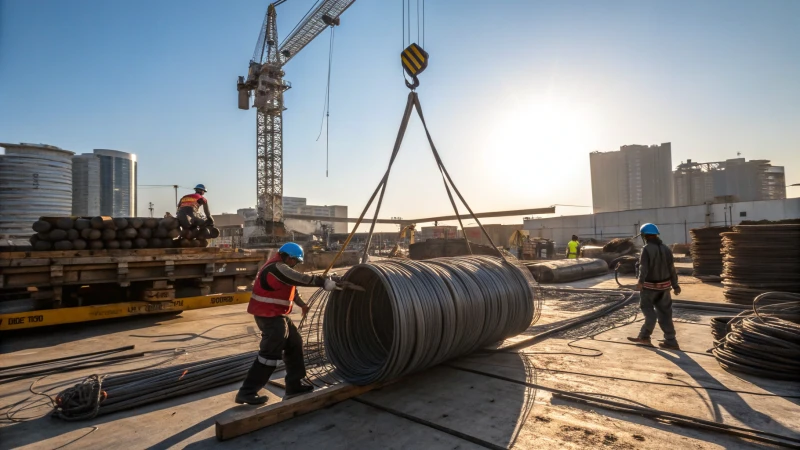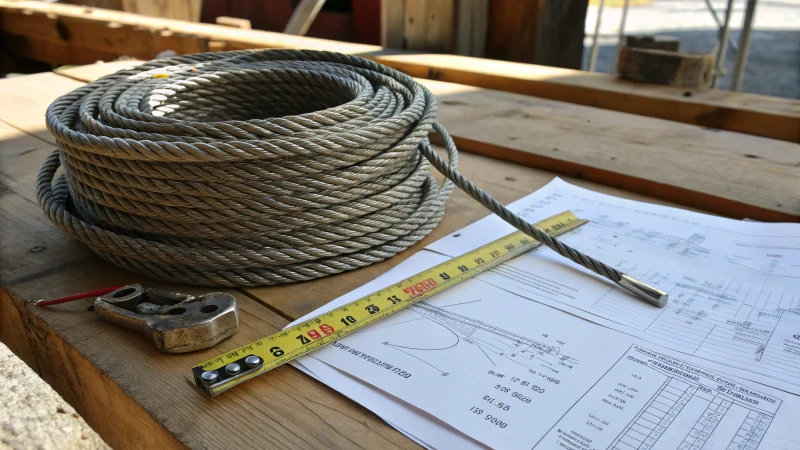
Ever wondered how steel wire ropes bear such immense loads without breaking a sweat? Let's dive into their secrets.
The load rating of a steel wire rope is determined by its tensile strength, diameter, and material type. Safety factors, typically ranging from 5 to 10, ensure safe operation, with higher factors used in critical applications like offshore or heavy lifting.
Understanding the load ratings and safety factors of steel wire ropes is crucial for safe and efficient use. Let me take you back to when I first learned about these concepts during a major project. I was overwhelmed by the sheer complexity of choosing the right rope for different tasks. After digging into the details, it became clear that knowing these ratings isn't just a technical necessity—it's essential for safety and success.
In this post, I want to share some insights on how to select the right rope for your application and ensure you meet all safety standards. Whether you're working on a skyscraper or deep in a mine, understanding these factors can make all the difference.
Steel wire ropes are used in both construction and mining.True
Steel wire ropes provide strength and durability essential for these industries.
Safety factors for steel wire ropes are always below 5.False
Safety factors typically range from 5 to 10, especially in critical applications.
How is the load rating of steel wire rope calculated?
Ever wondered how much weight a steel wire rope can actually hold? It’s not just guesswork—there’s a whole science behind it, and it’s crucial for safety!
The load rating of steel wire rope is calculated by factoring in the rope's diameter, material, tensile strength, and a safety factor to ensure it can handle the loads safely.

Understanding the Basics
I remember my first time dealing with steel wire ropes—it was on a construction site where every lift seemed like a test of nerves. But the key to keeping cool was understanding how the load rating, or safe working load (SWL), was calculated. It all starts with grasping the tensile strength1 of the wire rope, which is influenced by several factors:
- Diameter: Picture this—like when you try lifting with a thicker grip at the gym, a larger rope diameter generally means it can handle more weight.
- Material Composition: Choosing between stainless steel and galvanized steel is like deciding between two superheroes; one is more resistant to rust, while the other offers brute strength.
- Construction Type: Think of it like pasta—different shapes mean different strengths. Compacted strands in wire ropes can pack more punch without bulking up.
Using Safety Factors
Safety factors are like that extra seatbelt you use when driving through a storm—they're multipliers that help determine the safe working load by accounting for unexpected stresses. Depending on where and how you're using the rope, these factors typically range from 5 to 10:
| Application | Safety Factor |
|---|---|
| General Lifting | 5 |
| Offshore Operations | 6-8 |
| Mining Applications | 7-9 |
| Critical Lifting Tasks | 10 |
Calculating the Load Rating
The calculation process might seem daunting, but here’s how I learned to break it down:
- Determine the Tensile Strength: Check the manufacturer's specs—it’s like having the cheat sheet right there.
- Apply the Safety Factor: Simply divide the tensile strength by your chosen safety factor to find out how much you can safely lift.
Imagine this: you’ve got a rope with a tensile strength of 10,000 lbs. If you apply a safety factor of 5, your SWL would be 2,000 lbs. It’s like knowing exactly how many bags of cement you can safely haul up without worry!
Advanced Considerations
Life isn’t always straightforward, and neither is selecting wire ropes for special conditions. Whether you're working in extreme temperatures or corrosive environments, additional adjustments might be needed. Here’s where consulting with industry experts2 can save the day:
- Temperature Adjustments: Just like how hot weather affects your car tires, higher temperatures can reduce rope strength.
- Corrosion Resistance: Essential in marine settings; otherwise, your rope might have a shorter lifespan than expected.
By understanding these aspects, I’ve found it much easier to choose the right wire rope for specific needs, ensuring both safety and efficiency in every operation.
Larger diameter ropes have higher load capacity.True
A larger diameter usually means a higher load capacity due to increased strength.
Safety factors for general lifting are typically 10.False
For general lifting, safety factors typically range from 5, not 10.
How Does the Safety Factor Influence Rope Selection?
I remember standing on a construction site, staring up at a massive crane. It hit me then how crucial rope safety factors are in ensuring everyone gets home safely.
The safety factor in rope selection acts as a buffer, multiplying the maximum load a rope can safely bear to accommodate unexpected stresses, ensuring both safety and reliability across different applications.

Understanding Safety Factors
Have you ever wondered about the unsung heroes in heavy lifting? Yep, ropes! And right there with them is the safety factor—a nifty ratio ensuring these ropes don't snap under pressure. Think of it as a cushion between the rope's ultimate breaking strength and its working load, especially vital in high-risk fields like construction and mining3. This safeguard ensures that no matter how unpredictable things get, safety remains uncompromised.
Calculating the Safety Factor
Picture this: you're deep into planning for an offshore project. The environment is harsh—corrosion and wave impact are relentless. Here's where calculating the right safety factor becomes essential. Consider what you're lifting, the surrounding conditions, and any dynamic forces at play. Check out this quick guide for typical safety factors:
| Application | Typical Safety Factor |
|---|---|
| General Lifting | 5 to 6 |
| Offshore | 7 to 8 |
| Mining | 6 to 10 |
For those wild offshore adventures, a higher safety factor is your best bet.
Practical Implications
Navigating through procurement decisions can feel like walking a tightrope—pun intended. Take mining, for example. Heavy loads and abrasive materials call for a safety factor of around 10, giving you peace of mind against unexpected challenges. Imagine selecting a rope without this buffer; the risk isn't just professional but personal—lives could be at stake.
Advances in Rope Technology
Here's some good news: technology is on our side. Modern ropes with compacted strands offer more strength without bulking up in diameter. This means you can still achieve those stringent industry standards with greater ease. As someone who's been in the thick of this decision-making process, it's reassuring to know that we have options that provide both durability and compliance.
By understanding how to pick the right rope and safety factor, I ensure not only operational efficiency but also uphold the safety standards that keep our team secure every single day.
Safety factors for mining ropes range from 6 to 10.True
Mining ropes need higher safety factors due to heavy loads and abrasive conditions.
Offshore ropes typically have a safety factor of 3 to 4.False
Offshore ropes generally require higher safety factors, around 7 to 8, for harsh conditions.
Why Do Safety Factors Vary Across Different Applications?
Ever wonder why some projects demand stricter safety measures than others? Dive in to discover why safety factors vary based on the risks and conditions involved.
Safety factors are higher in applications like offshore drilling and heavy lifting due to unpredictable conditions, high stakes, and the need for utmost reliability. These factors account for dynamic loads, material fatigue, and environmental stresses.

Critical Nature of Operations
Imagine working on a project where even the tiniest error could lead to disastrous results. That's the reality in industries like aerospace and nuclear energy. When I first learned about the extreme safety measures required in these fields, it was clear why the safety factors4 had to be so high. In such critical operations, the stakes are incredibly high—it's not just about doing a good job; it's about ensuring safety and avoiding catastrophe.
Environmental Considerations
I remember a time when I was involved in a project near the coast, and the challenges posed by the salty air and unpredictable weather were eye-opening. Similarly, offshore drilling operations are exposed to some of the harshest environments imaginable—corrosive saltwater and immense underwater pressures. It's no surprise that steel wire ropes used here need to withstand such conditions, which is why they come with a higher safety factor5.
| Application Area | Typical Safety Factor |
|---|---|
| Aerospace | 1.5 - 3 |
| Offshore Drilling | 6 - 10 |
| Construction | 3 - 5 |
Dynamic Loads and Material Fatigue
Have you ever watched a crane at work on a construction site? The loads they lift vary so much—one moment it's a stack of bricks, the next it's a steel beam. This variability can lead to material fatigue over time. I’ve seen firsthand how crucial it is for cranes and other heavy lifting equipment to have higher safety factors, ensuring reliability despite these ever-changing forces.
Technological Advancements
With each advancement in technology, we often think we've conquered yet another challenge. For instance, the development of compacted strands in steel wire ropes offers greater strength without increasing their size. But even with these innovations, maintaining higher safety factors remains essential. I’ve realized that these factors act as a buffer, providing peace of mind against any unforeseen challenges.
Regulatory Requirements
Regulations might seem like red tape sometimes, but they play an essential role in keeping us safe. I once had to navigate a maze of regulatory standards for a project, and it was reassuring to know that these rules ensured every product met minimum safety criteria. Industries must comply with these standards, which often dictate necessary safety factors to protect everyone involved.
Understanding these reasons behind varying safety factors helps us all—from engineers to procurement managers like John6 or Emma7—make informed decisions that prioritize both safety and efficiency.
Aerospace applications use safety factors of 1.5 to 3.True
Aerospace industries require higher safety factors due to critical failure risks.
Offshore drilling uses lower safety factors than construction.False
Offshore drilling uses higher safety factors due to harsh conditions.
How Do Advancements in Rope Construction Affect Load Ratings?
Ever wondered how those sleek, modern ropes can handle so much weight? Let’s unravel the secrets behind their amazing strength and durability.
Advancements in rope construction, like compacted strands and hybrid materials, boost load ratings by enhancing tensile strength and durability without increasing diameter. These innovations enhance safety and efficiency in fields such as construction and mining.

Understanding Rope Construction Innovations
I remember the first time I saw a rope with compacted strands—it was like seeing a magic trick. The strands were pressed together so tightly, you’d think it was all one piece. This innovation significantly boosts a rope's tensile strength while keeping its diameter the same. It's like getting more muscles in the same size package!
Compacted Strands: A Closer Look
I recall a project where we had to lift some seriously hefty equipment. The regular ropes just weren't cutting it. Then, we switched to compacted strand ropes8. It was a game changer! For the same diameter, these ropes could handle heavier loads, ensuring everything ran smoothly and safely.
| Type of Rope | Load Capacity (kg) | Diameter (mm) |
|---|---|---|
| Standard Rope | 1000 | 10 |
| Compacted Strand Rope | 1200 | 10 |
This table clearly shows how compacted strands ramp up the load ratings.
Hybrid Materials in Rope Construction
Have you ever seen a rope that’s both strong and light as a feather? That’s what hybrid materials bring to the table. By blending steel with synthetic fibers, ropes become incredibly adaptable. I once worked on an offshore project where these ropes were indispensable, resisting harsh conditions while performing flawlessly.
Besides strength, these hybrid ropes resist environmental nasties like corrosion and UV rays, meaning they last longer and maintain their load capacity over time.
Safety Factors in Load Ratings
The real peace of mind comes from the safety factor in rope design. I’ve seen firsthand how new technologies help ropes keep their cool under unexpected stress, maintaining higher safety margins. In mining, where unpredictability is the norm, using ropes with a high safety factor (sometimes up to 10) is essential.
For more insights on how safety factors impact load ratings9, consider how they influence industries heavily reliant on steel wire ropes.
By digging into these advancements, businesses can better align modern rope constructions with their needs, boosting safety and efficiency. With innovations like compacted strands and hybrid materials, the possibilities for enhancing load ratings in demanding scenarios are practically limitless.
Compacted strands increase rope load capacity by 20%.True
Compacted strands enhance tensile strength, allowing ropes to bear heavier loads.
Hybrid ropes are less resistant to UV radiation.False
Hybrid materials improve resistance to environmental factors like UV radiation.
Conclusion
Steel wire ropes' load ratings depend on tensile strength, diameter, and material. Safety factors, ranging from 5 to 10, ensure safe operation in various applications like construction and mining.
-
Discover detailed insights into how tensile strength affects wire rope performance and load ratings. ↩
-
Explore expert recommendations for choosing and using wire ropes in specific industries. ↩
-
Discover how different industries apply safety factors to ensure reliable and safe operations. ↩
-
Explore why aerospace engineering demands high safety factors and the consequences of failure. ↩
-
Learn about the harsh conditions in offshore drilling that necessitate higher safety factors. ↩
-
Understand construction safety standards that procurement managers need to adhere to. ↩
-
Discover how mining operations maintain equipment reliability under extreme conditions. ↩
-
Explore how compacted strands increase tensile strength and reduce diameter without sacrificing performance. ↩
-
Understand the role of safety factors in determining reliable load ratings across different applications. ↩

